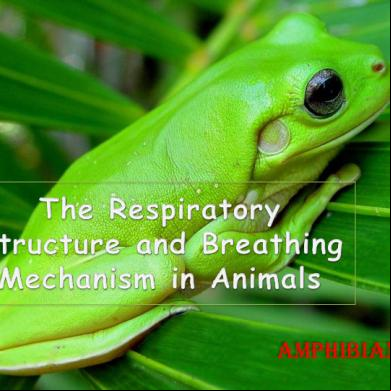The Respiratory Structure And Breathing Mechanism In Animals wf2x
This document was ed by and they confirmed that they have the permission to share it. If you are author or own the copyright of this book, please report to us by using this report form. Report 3i3n4
Overview 26281t
& View The Respiratory Structure And Breathing Mechanism In Animals as PDF for free.
More details 6y5l6z
- Words: 449
- Pages: 6
AMPHIBIANS
Amphibians, such as frogs, live partly on land and partly in water. As such, their respiratory structure must be adapted so they can breathe both in water and on land. They breathe through the skin, mouth and lungs. Therefore, the mechanism of respiration for the amphibian involves three methods:
Amphibians
Amphibians, such as frogs, live partly on land and partly in water. As such, their respiratory structure must be adapted so they can breathe both in water and on land. They breathe through the skin, mouth and lungs. Therefore, the mechanism of respiration for the amphibian involves three methods:
Respiratory structure of a frog Adaptation for cutaneous respiration The skin of amphibians adapts as it is thin so as to allow gaseous exchanges to occur easily and efficiently. When the amphibians are on land, the skin is also moist so that the gases from the atmosphere can be dissolved readily. There are also many blood capillaries in the skin so that when they are in water, the large number of blood capillaries increases the rate of exchanges of the oxygen and carbon dioxide between the blood capillaries and the surrounding water.
Adaptation for buccal respiration The thin wall of the large mouth cavity contains many blood capillaries. The large number of blood capillaries increases the rate of diffusion of oxygen and carbon dioxide in the mouth cavity. At the same time, the thin epithelium lining is moist. This facilitates the gaseous exchanges through the epithelium.
Adaptation of lungs for pulmonary respiration Amphibians use pulmonary respiration when they are on land. The inner walls of the lungs are heavily folded. This increases the surface area and thus increases the rate of gaseous exchanges. The walls of the lungs are also thin and this allows the gases to diffuse readily. The walls are also moist, enabling the oxygen to dissolve first in them before diffusing across. There are also networks of blood capillaries on the walls of the lungs which help to increase the rate of gaseous exchanges.
The breathing mechanism of pulmonary respiration During inhalation, the floor of the mouth is lowered. The volume inside the mouth increases and the pressure decreases. Due to the pressure differences, air is drawn through the nostrils into the mouth. The nostrils then close and the floor of mouth rises. The pressure in the cavity increases and air is forced into the lungs. The gaseous exchanges take place between the blood in the lung capillaries and the inhaled air. During exhalation, the nostrils open and the air is pushed out through the glottis, buccal cavity and the nostrils. This is achieved by the contraction of the abdominal muscles which pressi against the lungs.
Amphibians, such as frogs, live partly on land and partly in water. As such, their respiratory structure must be adapted so they can breathe both in water and on land. They breathe through the skin, mouth and lungs. Therefore, the mechanism of respiration for the amphibian involves three methods:
Amphibians
Amphibians, such as frogs, live partly on land and partly in water. As such, their respiratory structure must be adapted so they can breathe both in water and on land. They breathe through the skin, mouth and lungs. Therefore, the mechanism of respiration for the amphibian involves three methods:
Respiratory structure of a frog Adaptation for cutaneous respiration The skin of amphibians adapts as it is thin so as to allow gaseous exchanges to occur easily and efficiently. When the amphibians are on land, the skin is also moist so that the gases from the atmosphere can be dissolved readily. There are also many blood capillaries in the skin so that when they are in water, the large number of blood capillaries increases the rate of exchanges of the oxygen and carbon dioxide between the blood capillaries and the surrounding water.
Adaptation for buccal respiration The thin wall of the large mouth cavity contains many blood capillaries. The large number of blood capillaries increases the rate of diffusion of oxygen and carbon dioxide in the mouth cavity. At the same time, the thin epithelium lining is moist. This facilitates the gaseous exchanges through the epithelium.
Adaptation of lungs for pulmonary respiration Amphibians use pulmonary respiration when they are on land. The inner walls of the lungs are heavily folded. This increases the surface area and thus increases the rate of gaseous exchanges. The walls of the lungs are also thin and this allows the gases to diffuse readily. The walls are also moist, enabling the oxygen to dissolve first in them before diffusing across. There are also networks of blood capillaries on the walls of the lungs which help to increase the rate of gaseous exchanges.
The breathing mechanism of pulmonary respiration During inhalation, the floor of the mouth is lowered. The volume inside the mouth increases and the pressure decreases. Due to the pressure differences, air is drawn through the nostrils into the mouth. The nostrils then close and the floor of mouth rises. The pressure in the cavity increases and air is forced into the lungs. The gaseous exchanges take place between the blood in the lung capillaries and the inhaled air. During exhalation, the nostrils open and the air is pushed out through the glottis, buccal cavity and the nostrils. This is achieved by the contraction of the abdominal muscles which pressi against the lungs.










